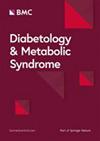糖尿病患者肌少症风险预测模型的构建与评估:基于中国健康与退休纵向研究(CHARLS)的研究
IF 3.4
3区 医学
Q2 ENDOCRINOLOGY & METABOLISM
引用次数: 0
摘要
肌肉疏松症是糖尿病的常见并发症。然而,精确评估糖尿病患者的肌肉疏松症风险仍是一项巨大挑战。本研究旨在建立一个提名图模型,作为诊断糖尿病患者肌肉疏松症的实用工具。本研究共纳入了 783 名来自 2015 年中国健康与退休纵向研究(CHARLS)的糖尿病患者。经过超采样处理后,1000 个样本被随机分为训练集和内部验证集。为了减轻超采样造成的过拟合效应,研究采用了 CHARLS 2011 的数据作为外部验证集。采用最小绝对收缩和选择算子(LASSO)回归分析和多元逻辑回归分析来探索预测因素。随后,根据 9 个选定的预测因子建立了一个提名图。通过接收者操作特征曲线(ROC)下面积(AUC)来评估模型的区分度,通过校准曲线来评估校准度,通过决策曲线分析(DCA)来评估临床疗效。此外,我们还构建了机器学习模型,以增强研究结果的稳健性并评估预测因素的重要性。我们选择了 9 个因素作为糖尿病患者肌肉疏松症的预测因子。提名图模型在训练集、内部验证集和外部验证集上都表现出良好的区分度,AUC 分别为 0.808、0.811 和 0.794。机器学习模型显示,年龄和血红蛋白是最重要的预测因子。校准曲线和 DCA 表明该模型具有良好的校准性和临床适用性。该综合提名图具有很高的临床预测性,是评估糖尿病患者肌肉疏松症风险的理想工具。本文章由计算机程序翻译,如有差异,请以英文原文为准。
Construction and evaluation of sarcopenia risk prediction model for patients with diabetes: a study based on the China health and retirement longitudinal study (CHARLS)
Sarcopenia is a common complication of diabetes. Nevertheless, precise evaluation of sarcopenia risk among patients with diabetes is still a big challenge. The objective of this study was to develop a nomogram model which could serve as a practical tool to diagnose sarcopenia in patients with diabetes. A total of 783 participants with diabetes from China Health and Retirement Longitudinal Study (CHARLS) 2015 were included in this study. After oversampling process, 1,000 samples were randomly divided into the training set and internal validation set. To mitigate the overfitting effect caused by oversampling, data of CHARLS 2011 were utilized as the external validation set. Least absolute shrinkage and selection operator (LASSO) regression analysis and multivariate logistic regression analysis were employed to explore predictors. Subsequently, a nomogram was developed based on the 9 selected predictors. The model was assessed by area under receiver operating characteristic (ROC) curves (AUC) for discrimination, calibration curves for calibration, and decision curve analysis (DCA) for clinical efficacy. In addition, machine learning models were constructed to enhance the robustness of our findings and evaluate the importance of the predictors. 9 factors were selected as predictors of sarcopenia for patients with diabetes. The nomogram model exhibited good discrimination in training, internal validation and external validation sets, with AUC of 0.808, 0.811 and 0.794. machine learning models revealed that age and hemoglobin were the most significant predictors. Calibration curves and DCA illustrated excellent calibration and clinical applicability of this model. This comprehensive nomogram presented high clinical predictability, which was a promising tool to evaluate the risk of sarcopenia in patients with diabetes.
求助全文
通过发布文献求助,成功后即可免费获取论文全文。
去求助
来源期刊

Diabetology & Metabolic Syndrome
ENDOCRINOLOGY & METABOLISM-
CiteScore
6.20
自引率
0.00%
发文量
170
审稿时长
7.5 months
期刊介绍:
Diabetology & Metabolic Syndrome publishes articles on all aspects of the pathophysiology of diabetes and metabolic syndrome.
By publishing original material exploring any area of laboratory, animal or clinical research into diabetes and metabolic syndrome, the journal offers a high-visibility forum for new insights and discussions into the issues of importance to the relevant community.
 求助内容:
求助内容: 应助结果提醒方式:
应助结果提醒方式:


